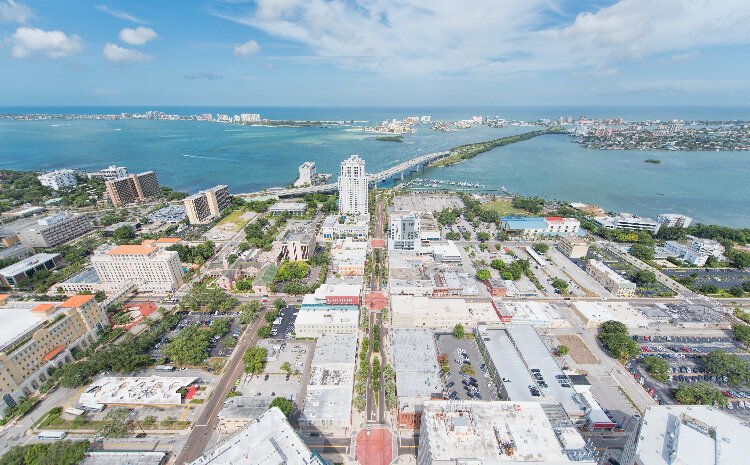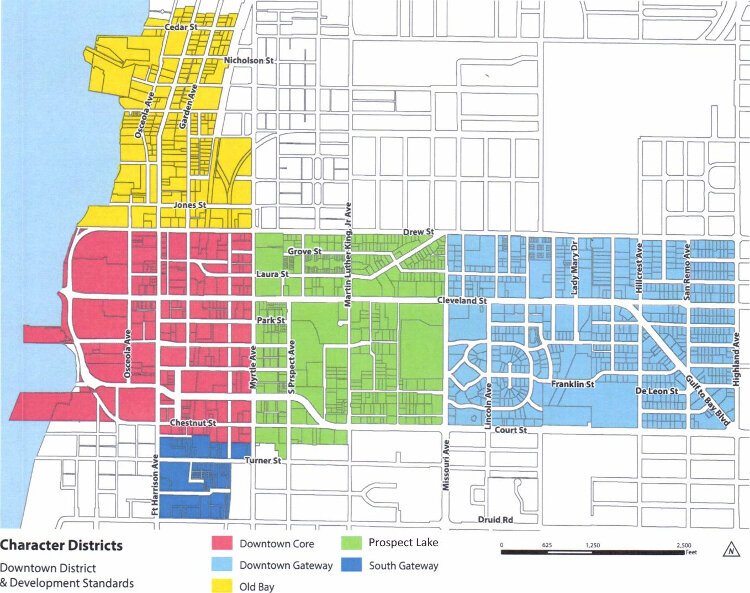Partner Partner Content City of Clearwater unveils new tool to spur redevelopment
Clearwater's Public Amenities Incentive Pool offers developers density bonuses for projects that include Class A office space, public parking, residential rental units and other uses that benefit the larger community.
The City of Clearwater’s Economic Development Division and 83 Degrees Media have an underwriting agreement in place to spotlight the city’s economic development programs and initiatives. This is the third in a series of four stories.
The City of Clearwater bills itself as “Bright and Beautiful, Bay to Beach.” Soon, the popular waterfront hub of nearly 120,000 may find itself with a taller skyline too, thanks to one recent initiative to help bolster building densities and increase worker salaries.
City officials recently established the Public Amenities Incentive Pool to help redevelop downtown Clearwater with a denser urban core that fosters better integration with the surrounding community. This initiative could help bring in high-end office spaces occupied by large corporations and technical firms offering Clearwater residents lucrative careers. This, in turn, could continue to diversify the city’s economy and attract high-wage jobs.
A vision for Clearwater’s future
“The Public Amenities Incentive Pool was created to ensure downtown redevelops with quality urban design, a high-quality public realm, and a dense and livable pattern of development,” Economic Development and Housing Department Director Denise Sanderson says. “This new program allows developers to access additional density by way of including the desired amenities or uses, including rental residential units, overnight accommodations, Class A office space, Leadership in Energy and Environmental Design (LEED) gold certification, public parking, public art, streetscaping and electric vehicle parking spaces.”
“By increasing the maximum development per acre, particularly in the downtown core, we will see increased residential units, hotels, offices and other desired uses that will further yield increased activity at Coachman Park,” Sanderson adds. “Coachman Park is a wonderful amenity for those living and working in the downtown area.”
The program, which went into effect after the Pinellas County Commission approved it on July 18, 2023, provides incentives for increased density in new developments in five “character districts” in and around downtown Clearwater. These districts include the Downtown Clearwater Core, Downtown Gateway, Old Bay, Prospect Lake and South Gateway. The areas are mostly clustered in and around the downtown neighborhoods west of Highland Avenue and broadly flanking the Cleveland Street corridor. The incentives will be in place indefinitely and are tiered based on which elements developers incorporate into their projects.
For example, developers who include market-rate or affordable rental housing units could see a 40% residential density bonus over zoning allowances in all character districts. Those who build Class A office spaces in the Downtown Core get a boost of 25% floor-area ratio (FAR). Achieving LEED gold certification or its equivalent can garner a 35% boost in residential density, a 20% increase in hotel density, and a 20% FAR boost in all districts.
“The vision is to have a thriving, densely built urban core that is an attractive and active place to live, work, shop, and play,” says Sanderson.
Since the program is so new, there are no completed projects that have benefited from these bonus incentives. Sanderson says some projects are currently in review.
A timeline for progress
Philip Kirkpatrick, Clearwater’s senior economic development coordinator, explains that one of the core reasons the city is incentivizing denser growth is the lack of undeveloped land in the region.
“There is little to no greenfield building space,” he says. “There are a couple of exceptions – maybe a half-acre here or there.”
However, the city needs to see denser growth to attract the types of major corporations, including headquarters offices, to help increase employment numbers and improve salaries for Clearwater residents.
“This is done by building more Class A offices that employ these people,” Kirkpatrick says.
But there’s another reason Clearwater leaders believe density bonuses make sense for the city today.
“The challenge, which is true pretty much in the entire Tampa Bay Area, is the value of real estate has increased significantly,” Kirkpatrick says.
He says rising land values make it harder for developers to reach profitability unless their projects can achieve higher density, whether it be in the form of increased housing units, larger office floor area, or other components that maximize the potential of the land underneath.
“In order to attract companies that are in information technologies, finance, insurance, and so on, we need office space for them to move into,” Kirkpatrick says.
To do that, the city needs Class A office space, along with higher-density residential developments and mixed-use projects, to create a fully integrated live-work-play environment.
Even with the newly adopted Public Amenities Incentive Pool in play, the type of mixed-use developments that offer live-work-play opportunities and create a vibrant urban hub will take time.
“My expectation is we will see material change over the next 10 years,” Kirkpatrick says. “For most of us in our lives, a decade seems like a really significant amount of time, but in the world of real estate development, it’s not as long a period of time as you might expect. I believe there will be material changes over the next decade with at least two to four substantial projects.”
“It’s really like a long game of chess,” he adds.
For more information, go to Clearwater Economic Development.
For prior stories, go to Clearwater adds real estate savvy to its economic development team and Clearwater sees U.S. 19 as Tampa Bay’s next booming corridor.















